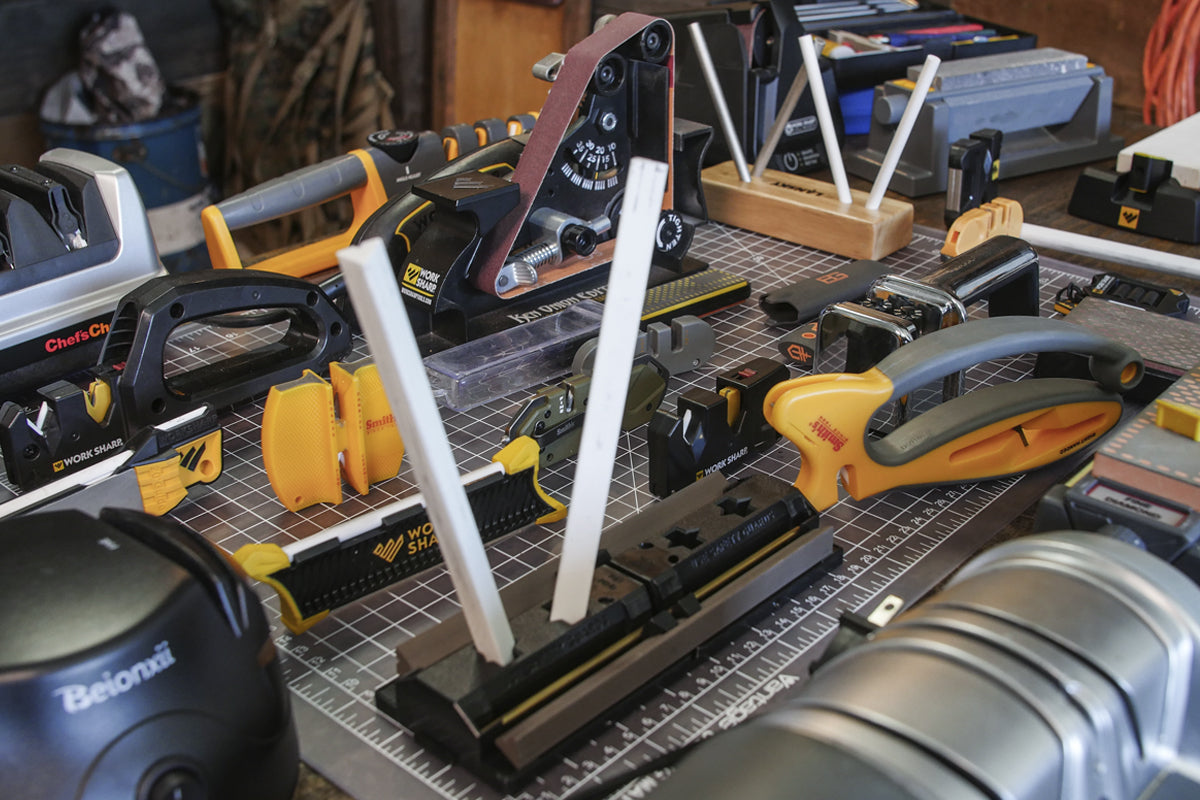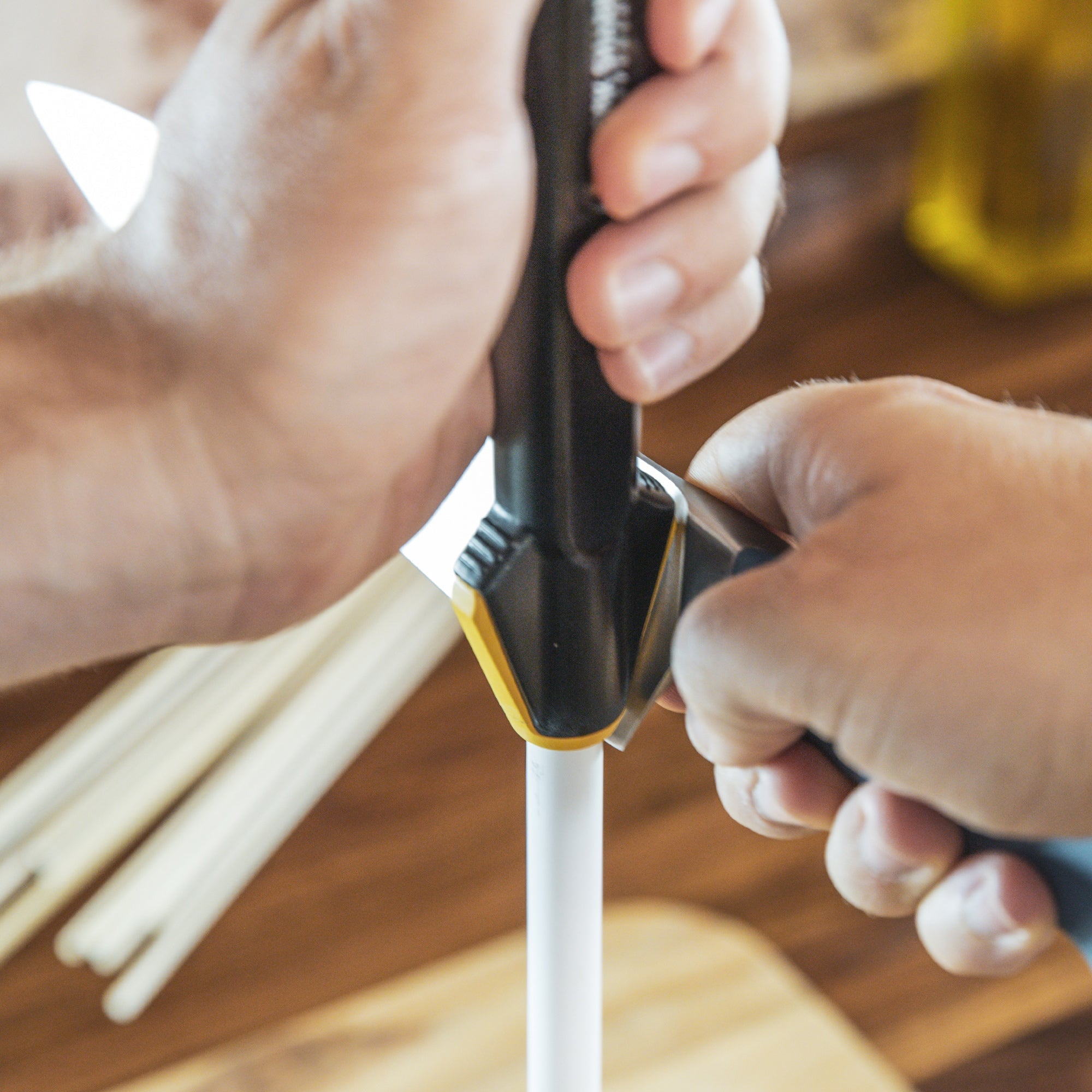Have you ever found yourself online or in the store aisle looking at all the options of knife sharpeners? There are manual solutions and powered units, all with a variety of feature sets. Knowing which option is right for you can become quite a task when it comes to comparing and evaluating.
Today in the Workshop, Josh and Kyle from Work Sharp give a quick overview on the different type of sharpeners on the market and provide some insight into the manual and powered sharpening categories.
Manual Sharpening Solutions
There are four main categories when looking at manual sharpeners.
- Pull-Through: A modestly priced solution that is great for hand-held countertop sharpening, or to take on-the-go in your pack or tool kit. Carbide and ceramic slots make this functional sharpening process a great entry point to knife sharpening. These sharpeners are an effective on-the-go solution, and great for maintaining other tools like your garden shears or axes.
- Benchstone: Designed around stone abrasives to sharpen both knives and tools, this method of sharpening creates a flat grind and requires more hand work. Users will find there are many options available in this category varying on price, skillset, and performance - from basic sharp to a precise keen edge. Work Sharp offers benchstone sharpeners with built-in angles to eliminate guesswork and they come with a progression of grits to provide all the steps - shape, sharpen, and hone.
- Angle Control: While requiring a little more set-up and commitment, these sharpening solutions provide more angle control vs the benchstone. At a medium price point, bench-top angle control systems typically use finer grit abrasives and require regular upkeep to maintain your keen edge performance. This solution works well for developing and mastering angle control and are not designed for repairing damaged blades or re-establishing your edge.
- Jig & Clamp: The best manual system for precision and repeatability. These sharpening systems clamp your knife and, at a set angle, traverse abrasives along the edge of your blade. Set at a higher price point, the jig & clamp method requires more set-up and time spent sharpening. While easier to establish your skillset, these sharpening systems do require more commitment to learning the mechanisms of the tool and proper grit progression. With time and dedication to the craft, these systems are an excellent solution for shaping, sharpening, and honing.
Powered Sharpeners
For powered sharpening systems, there are two main categories: Shop vs Home. Both systems are designed so that the user is pulling the length of blade along a moving abrasive. The abrasive is doing the bulk of the work in this process and typically most powered sharpeners have set angles to maintain the knife edge.

HOME:
Typically found in the kitchen, these sharpeners are enclosed with slots that act as the guide for your knife – maintaining the proper angle and leading your blade along the abrasive. The abrasives used in an electric sharpener are a diamond wheel, abrasive disc, or abrasive belt.
Varying features of home kitchen sharpeners are set angle guides, type of abrasive, how/if the abrasive can be replaced, and some have options for a progression of grits. The quality of these feature sets and type of abrasive differ by home sharpening systems, along with price point.
While the mechanical instruction and layout for each sharpener will vary, the basics are the same: Establish the profile of the blade, sharpen, then refine (remove the burr).
Home sharpening systems are functional and easy to use. They help maintain your kitchen cutlery while being cleaner and more practical for in-the-home use.
SHOP:
While some powered systems can be high in price and lean more toward advanced industrial design, most home-shop sharpeners are priced for their value, quality, and ease of use.
Work Sharp has a variety of powered options to choose from that meet diverse skillsets while offering top of the line performance. The skillset is built into the tool, and yet these sharpeners also have the capability to expand into more customizable sharpening systems for those seeking more options.
Additionally, Work Sharp powered sharpeners for the shop can sharpen axes, hatchets, gardening tools, lawn mower blades, and more.
Check out the full video below for the entire review of these sharpening systems with Kyle and Josh from Work Sharp – and share with us what systems you are interested in using or what sharpening solutions you currently using to maintain all your knives. Tell us about your experience in the comments below.






